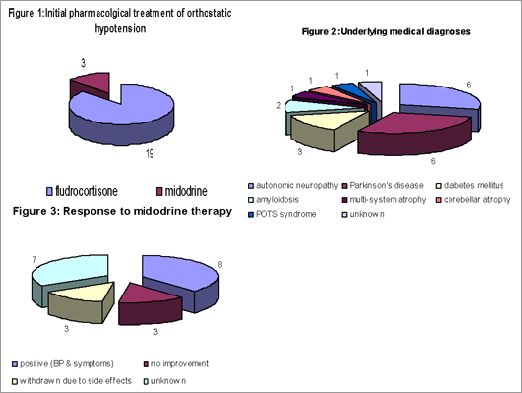061P Brighton
Winter Meeting December 2007 |
Midodrine therapy for orthostatic hypotension: an audit of prescribing practise at Addenbrooke’s Hospital, Cambridge, UK
Victoria Armitage, Fraz Mir, Kevin O’Shaughnessy
Clinical Pharmacology Unit, University of Cambridge, Addenbrooke’s Hospital, Cambridge, United Kingdom
Orthostatic hypotension is a common cause of collapse and admission to hospital. Treatment is usually indicated when a postural drop in blood pressure of at least 20mmHg systolic and/or 10mmHg diastolic occurs on assuming a standing position, and is accompanied by typical symptoms (dizziness, syncope, visual disturbance, or cognitive impairment). Multiple non-pharmacological “life-style” measures (eg. orthostatic training exercises, compression stockings, increasing dietary intake of salt and water and ceasing anti-hypertensive medication) have been shown to be beneficial and are the preferred first-line therapy. Subsequently, current expert advice suggests plasma volume expansion using pharmacological means (eg. fludrocortisone), followed by the addition of vasoconstricting agents such as midodrine. This is also the drug of choice in patients with proven autonomic dysfunction (recommended starting dose 2.5mg bd/tds) but is presently available in the UK on a named-patient basis only. Our aim was to investigate if the prescribing of midodrine at Addenbrooke’s conformed to these guidelines.
22 patients prescribed midodrine since 2001 were identified from the pharmacy database. Their clinical notes were examined and data collected using a pre-designed pro forma focusing on 3 key areas: initial management of orthostatic hypotension (Figure 1); the underlying medical diagnosis for which midodrine was prescribed (Figure 2); and the clinical response of patients treated with the drug (Figure 3).
The audit also revealed that a wide range of doses was employed when patients were started on midodrine (ranging from 2.5mg bd to 10mg tds); and that more than half the patients had no formal assessment of autonomic nervous system function.
In Addenbrooke’s Hospital, adherence to the European guidelines (Lahrmann et al 2006) for the management of orthostatic hypotension is poor and should be improved by their better implementation. Greater availability of autonomic function testing and educating physicians in midodrine’s appropriate usage should help facilitate this process.

Lahrmann H et al. European Journal of Neurology 2006; 13: 930-936
|